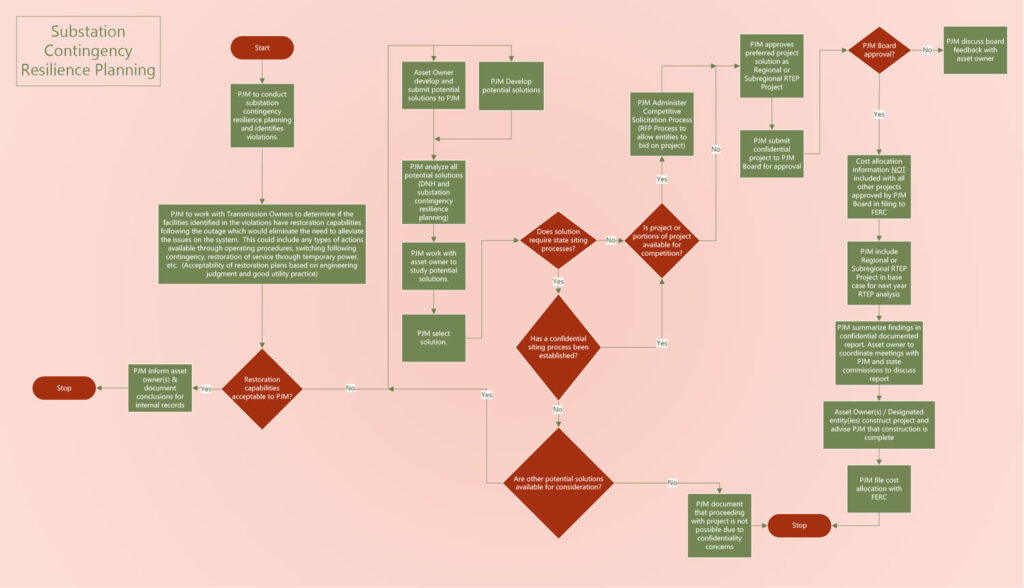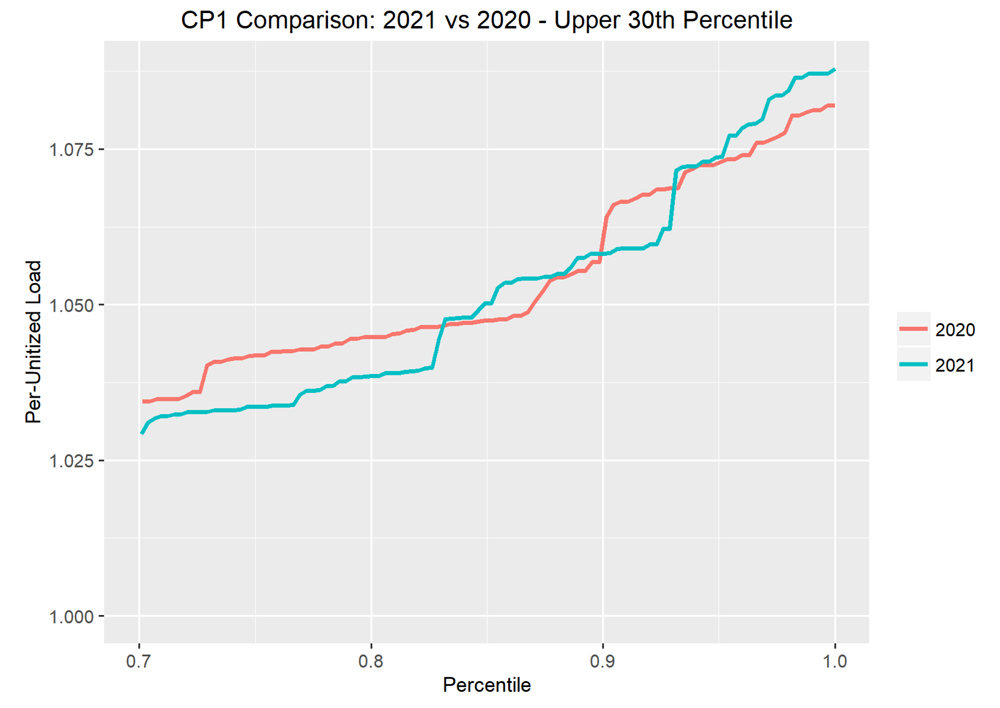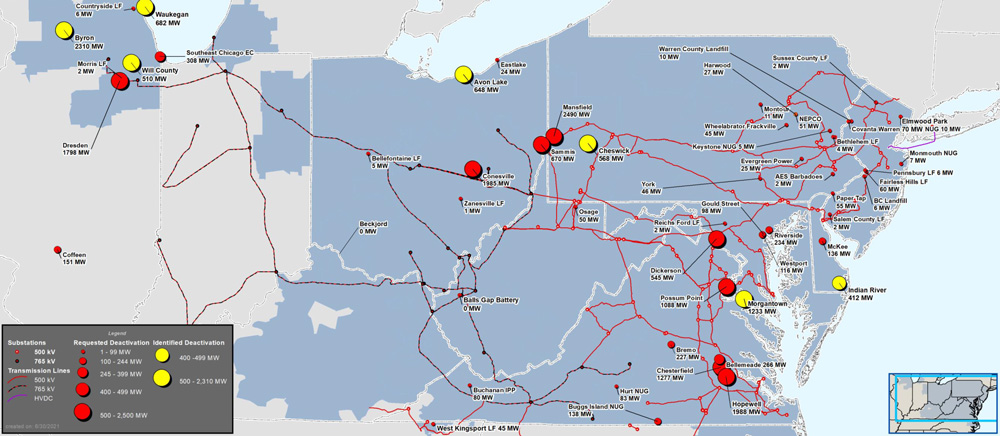
Planning Committee
CISO Mitigation Language Affirmed
PJM stakeholders voted last week to affirm the amended Operating Agreement language from the RTO’s mitigation proposal endorsed in February to avoid designating projects as critical infrastructure under NERC reliability standards.
The revised OA language passed at last week’s Planning Committee meeting with 134 stakeholder votes in support (87%) and 20 opposing. PJM’s Critical Infrastructure Stakeholder Oversight (CISO) mitigation proposal was originally endorsed at the February PC meeting with 61% support. (See “Critical Tx Infrastructure Proposals Endorsed,” PJM PC/TEAC Briefs: Feb. 9, 2021.)
A group of stakeholders at the April Markets and Reliability Committee meeting voted to remand the mitigation proposal to the PC for further discussions to determine if the revised OA language corresponded with that in the endorsed matrix. (See “CISO Mitigation Update,” PJM PC/TEAC Briefs: June 8, 2021.) Members endorsed the avoidance portion of the PJM proposal at the May MRC meeting. (See “CISO Avoidance Endorsed,” PJM MRC Briefs: May 26, 2021.)
Michael Herman of PJM’s transmission planning department led a discussion on the approved mitigation proposal, including a review of the revised OA language. Herman emphasized that last week’s PC vote was to determine whether the OA language was “in alignment” with the approved matrix and not to rule on the substance of the language itself.
Herman said PJM conducted a review of the OA language with its subject matter and legal experts as part of the development of the mitigation proposal and reviewed changes resulting from stakeholder discussions. He said the RTO based its review on changes made between the first read at the March MRC meeting and discussions the following month, researching whether the concepts were “in alignment” with what was approved in the matrix by the PC. (See “CISO First Read,” PJM MRC/MC Briefs: March 29, 2021.)
Herman said PJM examined the OA language defining a critical substation planning analysis (CSPA) project as a regional or subregional Regional Transmission Expansion Plan (RTEP) project “with an anticipated in-service date of more than three years but no more than five years from the year” in which the RTO identifies the need for the potential CSPA project. Herman said PJM determined that the in-service date language didn’t need to be included in the draft OA language because the concept “respects existing competitive rules and exemptions” that already exist in other parts of the OA and corresponding manual language.
Based on its five-year analysis, Herman said, PJM expects to identify critical facilities prior to the need for any immediate-need projects and felt changes were unnecessary to the proposed OA language.
“We do not anticipate many, if any, immediate-need projects coming through this process,” Herman said.
Erik Heinle of the D.C. Office of the People’s Counsel asked what Herman meant by that statement, specifically the “many” part.
Herman said the mitigation portion of PJM’s proposal is the “second level of protection” of a CSPA process, with the avoidance portion serving as the first level in the process. PJM anticipates performing analysis on all projects that may be included in the RTEP moving forward, Herman said, so updates to the RTEP will be tested individually so that the RTO doesn’t create a critical facility.
The second OA language piece PJM examined dealt with the RTO’s ability to determine if any component of a CSPA project can be included in a request for proposals window “without disclosing the location of or vulnerabilities associated with the critical substation contingencies and associated facilities.”
Herman said that as part of the competitive process and design component of the matrix, a project will be open to competition as part of an RFP process “if the mitigating solution does not disclose the substation associated with the substation contingency.” He said PJM recommended keeping the existing OA language.

“PJM believes that this language is valuable, is helpful and is very much in line with the package approved by the Planning Committee back in February,” Herman said.
The OA language now heads to the MRC for a first read July 28.
Manual 14A Revisions Endorsed
Members endorsed revisions to Manual 14A: New Services Request Process in a “quick fix” process for the close of queue date and application review timing changes. The revisions received 154 “yes” votes (95%).
Onyinye Caven of PJM reviewed the conforming Manual 14A language changes that were originally recommended by the Interconnection Process Reform Task Force as “enhancements to the queue process.” The revisions were first presented at the June PC meeting. (See “Manual 14A Updates,” PJM PC/TEAC Briefs: June 8, 2021.)
Caven said the manual changes impacting the close of the queue window and the deficiency review clock are a result of the new service requests issue charge endorsed at the May PC and MRC meetings. (See “New Service Requests Approved,” PJM MRC Briefs: May 26, 2021.) The proposed tariff changes were reviewed at the PC and MRC and were officially endorsed at the June Members Committee meeting.
The Manual 14A changes were made to align existing documentation with the new service requests proposal, Caven said. Current tariff language states that new service queue windows stay open from April 1 to Sept. 30 and Oct. 1 to March 31, while the proposed tariff language moves up those closing dates to Sept. 10 and March 10, shortening the queue for each respective window.
Currently PJM must review the new service customer’s response to the RTO’s deficiency notice within five business days. The proposed update would require PJM to review the response within 15 business days or “use reasonable efforts to do so as soon thereafter as practicable.”
Changes in the tariff language also include the deletion of the definition of new service queue closing date.
Caven said the Manual 14A updates mirror the proposed tariff language changes. PJM is looking for a final endorsement of the manual language at the July MRC meeting and an effective date of Sept. 1.
Paul Sotkiewicz of E-Cubed Policy Associates said he appreciated the work done by PJM staff to try to find a solution to manage the growing number of new service requests in the queue, but he continues to have concerns about the RTO’s solution. Sotkiewicz said the language revisions don’t solve the existing problem of giving PJM staff more time to review applications and to issue deficiency notices.
Sotkiewicz continued to suggest PJM institute a sliding scale on the cost to review projects, with companies turning in a new service application earlier in the window receiving a discount.
“It’s a Band-Aid on a gaping, open wound,” Sotkiewicz said. “And we’re going to be back here talking about the same problems again.”
Load Model Selection
PJM is recommending a 13-year load model using data from 2001 to 2013 for the 2021 reserve requirement study (RRS), moving the model up one year from the RSS approved for 2020.
Patricio Rocha Garrido of PJM’s resource adequacy department presented the results of the RTO’s load model selection process, which analyzed 120 load model candidates for the 2025/26 delivery year RRS. Rocha Garrido said the analysis was based on the 2021 PJM Load Forecast Report released in January.
The load model candidates were compared to PJM’s “coincident peak 1” (CP1) distribution analysis, Rocha Garrido said, which represents the highest load expected for the forecast year, using two separate approaches. The previously selected load model, a 13-year model using data from 2002 to 2014, was not one of the top candidates this year, Rocha Garrido said, because of a new CP1 distribution analysis that was “similar, but not identical.”
“The 2021 curve is a little bit more conservative and has higher loads relative to 2020,” Rocha Garrido said.
PJM had used a 10-year load model (2003-2012) for several years in a row before switching to a 13-year model in 2020. Rocha Garrido said the load model selection must be done because the coincident peak distributions from the PJM load forecast cannot be used directly in the PRISM modeling software.

The RTO is also making the recommendation to switch the peak week for the MISO, NYISO, TVA and VACAR regions, known as the “world” in the analysis, to a different week in July that it doesn’t coincide with its own peak.
Stakeholders will vote on endorsement of the load model selection at the August PC meeting.
Manual 20 First Read
Rocha Garrido also provided a first read of a cover-to-cover review of Manual 20: Resource Adequacy Analysis. He said the proposed minor revisions included cleaning up outdated and redundant language and ensuring the manual language follows current PJM processes.
One of the more significant changes included removing the Reliability Pricing Model (RPM) timeline from section 1.2 of Manual 20 because it already exists in Manual 18.
“It’s important to have the clarifying language and to eliminate some unnecessary language, but nothing here is going to shake the Earth,” Rocha Garrido said.
Rocha Garrido said one complication in the Manual 20 changes is a parallel effort currently being conducted at the MRC to update the manuals resulting from discussions addressing the effective load-carrying capability (ELCC) for limited-duration and intermittent resources. (See “ELCC Manuals,” PJM MRC/MC Briefs: June 23, 2021.)
The proposed ELCC changes are in section 5 of Manual 20, Rocha Garrido said, and were not included in the presentation at the PC meeting. He said the changes will be reflected if stakeholders endorse the ELCC manual changes at the July MRC meeting.
The PC will vote on the manual changes at the August meeting.
Transmission Expansion Advisory Committee
Generation Deactivation Notification
Phil Yum of PJM provided an update on 11 recent generation deactivation notifications totaling more than 6,000 MW.
Houston-based GenOn Holdings requested that Avon Lake 9 Generating Station, a 627-MW coal-fired unit, and Avon Lake 10, a 21-MW oil-fired unit, both located in the American Transmission Systems Inc. (ATSI) transmission zone in Ohio, and the Cheswick Generating Station, a 567.5-MW coal-fired unit in the Duquesne transmission zone in Pennsylvania, all be deactivated on April 1, 2022. GenOn had originally requested a deactivation date of Sept. 15.
GenOn also requested that Morgantown Generating Station Units 1 and 2, 613.3-MW and 619.4-MW coal-fired units located in the PEPCO transmission zone in Maryland, be deactivated on May 31, 2022.

Yum said PJM and transmission owners identified some reliability violations, but new and existing baseline projects will “resolve” the identified impacts and the units can retire as scheduled.
Reliability analyses are underway for six other generation units, Yum said.
Exelon requested that its two Byron nuclear units, both in the ComEd transmission zone in Illinois, be deactivated Sept. 14 and 16. The company originally announced in 2019 its intention to retire the units and reiterated its intention unless the Illinois legislature passed an energy package with support for the plant by June 15. (See Biden’s Support for Nuclear ‘Too Late’ to Save Exelon Plants.) The legislature did not, and Exelon notified PJM about the deactivation the following day.
NRG Energy requested that its Indian River 4 Generating Station, a 411.9-MW coal-fired unit in the Delmarva Power and Light transmission zone in Delaware, be deactivated on May 31, 2022. NRG also requested that the coal-fired Waukegan Generating Station Units 7 and 8 and the 510-MW coal-fired Will County Generating Station Unit 4, all located in ComEd, be deactivated the same day.

